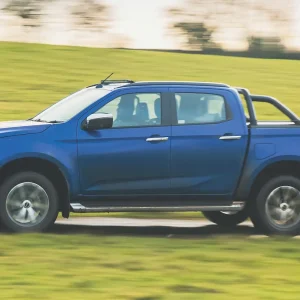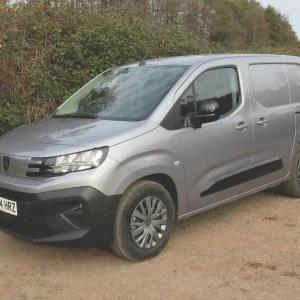Most Vitos now take a 2.1-litre diesel developing 95hp (110CDI), 136hp (113CDI) or 163hp (116CDI). If that’s not enough beef for you then you can always opt for the 122CDI 3.0-litre V6 common rail diesel instead. Offering a hefty 224hp, it is alas available solely with an automatic box, which can also be specified for the 113CDI and 116CDI as an option. The Vito is also produced with a 258hp petrol V6 engine – not offered in the UK – and in electric E-cell guise.
The diesel- and petrol-powered models are all rear-wheel drive, and a 4×4 is produced too. The E-cell is front-wheel drive however; the positioning of the batteries makes it impossible to fit a prop shaft.
Grossing at from 2.8 to 3.2 tonnes and with a payload capacity of from 865kg to 1180kg, the Vito is produced with three different body lengths (Compact, Long and Extra-Long) and either a standard or a high roof. Load cubes range from 5.2cu/m to 7.4cu/m. It is also available in Dualiner guise, with a second row of seats and a cargo area behind them, and as a Traveliner minibus.
We test drove the 110CDI short rear-overhang, standard-roof 3.2m-wheelbase Compact; not the most exciting van in the line-up, but likely to be one of the best-sellers.
Cab
Look for a conventional handbrake lever in the Vito’s roomy, comfortable cab and you will look in vain. Instead, it is equipped with a foot-operated parking brake. You apply it by pressing a small pedal to the left of the clutch pedal. To release, you pull a lever on the dash, to the accompaniment of a loud bang, and the pedal flies back up, with the threat of walloping the driver on the ankle. While a foot-operated parking brake may be acceptable in a vehicle fitted with an automatic gearbox, installing one in a van equipped with a manual ’box makes hill starts awkward to execute. A hill-hold function is available to stop you rolling back, but is an extra-cost option.
Mercedes is the only van maker to encumber its customers with a foot-operated solution and while we fervently wish it would not, it’s something regular Merc owners may well get used to.
Aside from the parking brake issue, the three-seater cab offers a pleasing working environment. There’s a reasonable amount of oddment storage space with a deep, lockable glovebox, capacious bins in each of the doors with a moulding to hold a big bottle of water or a flask, and an overhead shelf for sunglasses.
On top of the attractively styled dashboard there is a holster that can accommodate an A4 clipboard as well as small cubby-holes at each extremity of the fascia. A pop-out ashtray is accompanied by a pop-out cup-holder.
Both the driver’s seat and the steering column are height- adjustable, which means most people should achieve a comfortable driving position, though the pedals do sit uncomfortably upright.
Rather more troublesome were the controls for the heating and ventilation system, which take a little figuring out. It takes a while for the cab to warm up too; a penalty imposed by modern, fuel-efficient engines that throw off very little waste heat.
Positioning the gear-lever on a moulding that bulges out from the centre of the dashboard slightly impedes cross-cab movement, but that limitation is, of course, not unique to the Vito.
Load area
Entry to our demonstrator’s 5.2cu/m cargo bay was by means of a sliding door on each side,
with a step in each case to aid access, plus an opaque hatch-type rear door. While hatches provide some shelter from the elements if you happen to be working at the back of the vehicle they can make pallet loading difficult because the opened hatch may foul the forklift’s masts. Twin rear doors are offered as an option.
Six floor-mounted load tie-down rings are fitted as standard, along with a full-height, solid, steel bulkhead and a tailored timber floor cover.
The spare wheel is mounted above the nearside wheel-box. That makes it easy to access unless the interior is packed solid with goods, but it does steal some space. Not that we would knock the provision of a full-size spare. Despite the weight penalty it imposes, it has to be preferable to relying on an inflator/sealer.
Powertrain
Complying with the latest Euro5 exhaust emission regulations, the 110CDI’s four-cylinder in-line 16-valve common-rail diesel
comes with a chain-driven camshaft and a particulate trap. Like the other 2.1-litres, it is married to a six-speed manual gearbox as standard, with a
short first gear, but a long top gear. The 110CDI emits 13% less CO2 than the old Euro4 109CDI.
Chassis and steering
The Vito’s redesigned chassis features a reworked suspension system, with new transverse links and revised spring and damper settings. One positive result is that Vito doesn’t roll all that much when cornering. The body remains well-controlled as you power through corners, with none of the lurching and wallowing that sometimes plagues light commercial vehicles.
Air suspension is an option with automatic levelling control for the rear axle. Despite the extra expense it could be worth considering if you carry fragile goods or are running a minibus. Power-assisted rack-and-pinion steering offers an 11.8m turning circle and our demonstrator’s 16-inch steel wheels were shod with 195/65 R16C Michelin Agilis 51 tyres.
Performance
While the Vito handles well and is remarkably manoeuvrable – a big advantage if you are constantly trying to squeeze into city centre parking spaces – its suspension at times struggles to cope with some of Britain’s less-forgiving road surfaces, especially when the van is lightly laden. Things improve once you put a bit of weight in the back, but we nonetheless suspect the way in which the suspension is set up needs altering. Nor were we especially impressed with the quality of the gear change – it’s not as smooth as it ought to be and made it a little difficult to get the best out of the engine. 
The gearing is spot-on though, with that long top gear undoubtedly contributing to the Vito’s fuel economy. Nor did we feel short-changed by
the 110CDI’s 95 horses; they provide sufficient performance for most applications and do so reasonably quietly, although a 113CDI may make more sense if you do a lot of high-speed motorway runs.
While all the standard-height roof Vitos look stylish, the high-roof models present an ungainly profile, almost as though the roof has been tacked on as an afterthought. The previous model suffered from the same problem and it is a pity that no attempt has been made to rectify it this
time round.
Buying and owning
Electric windows are fitted along with a radio/CD player – there are remote controls for the latter on the steering wheel – a trip computer, Bluetooth connectivity and, perhaps surprisingly, cruise control. Our test vehicle boasted electrically adjustable exterior mirrors too for an additional £165.
Don’t be afraid of taking the Vito out in bad weather. With washer jets incorporated into their arms, the clap-hands style wipers are highly effective, eliminating the patches of dirt to be found in the top corners of many van windscreens.
All sorts of extra-cost options can be specified including satellite navigation, a rear-view camera to aid reversing and Bi-Xenon headlamps with a cornering light function.
It is worth noting that Mercedes has developed an optional fuel frugal/low CO2 BlueEfficiency package to make its light commercial vehicles more environmentally friendly. Features include low rolling-resistance tyres and stop/start, which stops the engine idling wastefully at the lights or in traffic.
The Mercedes Vito benefits from the support of a professional commercial vehicle network – more than 100 dealers at the last count – with ample UK-wide coverage.
Taking into account the van’s actual usage, an Assyst service computer is fitted that tells you when a workshop visit is genuinely required. The German manufacturer reckons that on average an oil change is likely to be required once every 30,000km/18,750mls.
It’s good to see that the three-year warranty is not restricted by a mileage limit; a useful benefit if you happen to be a high-mileage user. You get comprehensive roadside assistance for three years under the MobilityGo banner and a 12-year anti-perforation bodywork warranty is provided as well. Look after the Vito and it should retain upwards of 20% of its original purchase price after four years/80,000 miles according to KwikCarcost; one of the few in its class that will.
As for fuel economy, we averaged 33mpg in some admittedly foul weather. The quoted combined fuel consumption figure is 36.2mpg.
Safety
If you are looking for a commitment to safety, then look no further. All Vitos boast ESP
and ABS along with acceleration skid control, brake assist and
EBD. Daytime driving lights and a driver’s airbag comes as standard. A passenger airbag is to be found on the options list along with window and thorax bags. So is a tyre pressure monitoring system.
Turning to security, the doors can be locked/unlocked by hitting
a button on the dashboard – the cab and load area doors can be done separately – while remote central locking is included in
the deal.
History – from lacklustre to award winner
With one load cube (4.8cu/m) and one payload capacity (1055kg) the one-size-fits-all front-wheel drive Vito that debuted in the mid-1990s with an eye to appealing to customers who wanted something smaller than a Sprinter was a very different beast to its ultimate successor.
Initially powered by rather lacklustre diesels, the common rail engine subsequently fitted and offering at up to 122hp made it a much more satisfactory load shifter. The up-rated gearbox and clutch helped too. What Van? liked what had been done – “Vito is no longer a sluggard” – and made the Merc its Van of the Year for 1999.
The really big change occurred at the end of 2003 with the introduction of an all-new rear-wheel drive Vito offering three different lengths, a high-roof option and a redesigned interior and exterior, and this time we said: “It’s an excellent van with a great engine line-up. ” Subsequent upgrades have included the introduction of Euro5 models last year.
VERDICT
A solidly built, stylish-looking van with a comfortable cab, exemplary handling and sufficient performance for most applications,
it’s let down somewhat by its poor unladen ride and gear change; and we still don’t like that parking brake.





